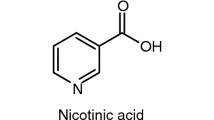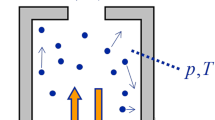Abstract
Procedures for measuring sublimation rates of pharmaceutical compounds by isothermal thermogravimetry are discussed. Experimental data was obtained using the Mettler TA4000 thermogravimetric system. The sublimation rate is measured directly from the mean weight loss per unit time in the linear region of the monitored TG profile at a set isothermal temperature. This data when fitted to the Arrhenius equation yields the sublimation enthalpy. For the benzoic acid reference, the enthalpy so calculated is 99% of the value obtained from direct vacuum TG measurements. Thermal degradation in the solid state or pre-melting can effect a departure from the characteristic linear mass loss-time sublimative profile. Data pertaining to several established Merck drugs is discussed. Examples where loss of residual solvent, onset of thermal degradation and pre-melting phenomena affect the measurement, are presented.
Similar content being viewed by others
References
USFDA Environmental Assessment Technical Guide No. 10.03, March 1987.
Official Journal of the European Communities L 251, 27 (1984) 25.
R. E. Dickerson, Molecular Thermodynamics, W. A. Benjamin Inc., Menlo Park, Cal. 1969, Chap. 5, pp. 229–232.
W. F. Spencer and M. M. Cliath, Environ. Sci. Technol., 3 (1969) 670.
W. F. Spencer, T. D. Shoup, M. M. Cliath, W. J. Farmer and R. Haque, J. Agric. Food Chem., 27 (1979) 273.
R. C. Paule and J. L. Margrave in The Characterization of High Temperature Vapors ed. J. L. Margrave, Wiley, N.Y. 1967, Chap. 6, pp. 130–151.
Institute of Petroleum Committee ST G-9, method IP 393/91.
ASTM E37 Committee on Thermal Measurements, task group E37.01.19.
W. Gückel, G. Synnatschke and R. Rittig, Pestic. Sci., 4 (1973) 137.
W. Gückel, R. Rittig and G. Synnatschke, Pestic. Sci., 5 (1974) 393.
W. Gückel, R. Kastel, J. Lewerenz and G. Synnatschke, Pestic. Sci., 13 (1982) 161.
W. Gückel, R. Kastel, T. Krohl and A. Parg, Pestic. Sci., 45 (1995) 27.
H. G. Wiedemann, Thermochim. Acta, 3 (1972) 355.
J. A. McCauley and H. G. Brittain, in Physical Characterization of Pharmaceutical Solids Ed. H. G. Brittain, Marcel Dekker Inc., N.Y. 1995, Chap. 8, pp. 241–243.
J. P. Elder, Internal Report (Merck and Co.) July 26, 1990.
J. P. Elder, Internal Report (Merck and Co.) September 24, 1992.
Merck Index, 11th edition, 1989, # 9374.
J. P. Elder, Internal Report (Merck and Co.) October 13, 1992.
Chemical and Engineering News (American Chemical Society) January 1, 1996, p. 6.
J. P. Elder, Internal Report (Merck and Co.) February 5, 1996.
Author information
Authors and Affiliations
Rights and permissions
About this article
Cite this article
Elder, J.P. Sublimation measurements of pharmaceutical compounds by isothermal thermogravivletry. Journal of Thermal Analysis 49, 897–905 (1997). https://doi.org/10.1007/BF01996775
Issue Date:
DOI: https://doi.org/10.1007/BF01996775




